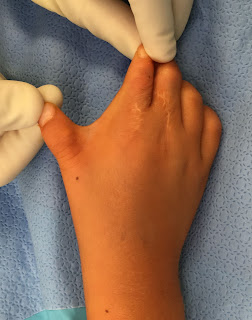The field of hand surgery was developed around the time of World War II combining the fields of orthopedics (care of bones, joints, tendons, muscle), plastic surgery (care of skin, soft tissues, and nerves) and vascular surgery (care of blood vessels). Given the very complex anatomy of the hand, wrist, and forearm, the concept of ‘hand’ surgeons trained with an anatomical focus in the upper extremity with expertise in the areas of orthopedics, plastic surgery, and vascular surgery makes a great deal of sense. This ‘new’ field of hand surgery has grown dramatically in the last 60 years.
Skin tightness or contracture is a common finding in the care of children with birth differences. The most serious skin deficit is syndactyly which, itself, varies in the degree. Treatment of syndactyly has been a repeated topic of the blog, see posts HERE.
Z- plasties are typically thought of as ‘plastic’ surgery procedures but in reality all hand surgeons, and especially those who treat kids, enjoy and utilize these procedures.
Tightness of the first webspace is seen in a number of different birth differences including the hypoplastic thumb, amniotic constriction band, simple or complex syndactyly, and symbrachydactyly. Treatment varies based on the exact nature of the tight first web space, ranging from a large rotation flap (as described by Buck Gramcko) or z- plasties (skin lengthening through re- arrangement).
Z- plasties are used in any area of the body where there is a skin contracture. The goal is simple: lengthen a tight band (no matter the cause). There are different types of z- plasties including 2- flap, 4- flap, and 5- flap (or running man flap). These flaps all lengthen the skin but with somewhat different benefits and challenges. The simplest of these is the 2- flap z- plasty for the obvious reason that it only involved two flaps of skin. These are typically designed at 60 degrees with each limb of equal length. The four and five flap z-plasties are a bit more complex to design but those who favor these flaps believe they create a more natural appearance of the lengthening. There is an excellent review of the basic 2 flap z- plasty HERE.
I will use different flaps including the 2 and the 5 flaps z- plasties most frequently.
Here is an example of the 2- flap z-plasty.
 |
| Tight first webspace in symbrachydactyly |
 |
| First webspace after 2-flap z-plasty |
 |
| Palm view of z- plasty after reconstruction. |
This technique creates a nice deepening of the space which is critical to improving large object grasp. I enjoy this operation as it can dramatically improve function with a relatively straightforward surgery- few surgeries provide such a functional improvement.
Finally, this image from the fastbleep.com website shows the 4 flap (both types) and 5 flap z- plasty. The bottom image is the 5- flap z-plasty which is also called the “running man” which combines a 4- flap z-plasty and an advancement flap.
Charles A. Goldfarb, MD
My Bio at Washington University
congenitalhand@wudosis.wustl.edu

